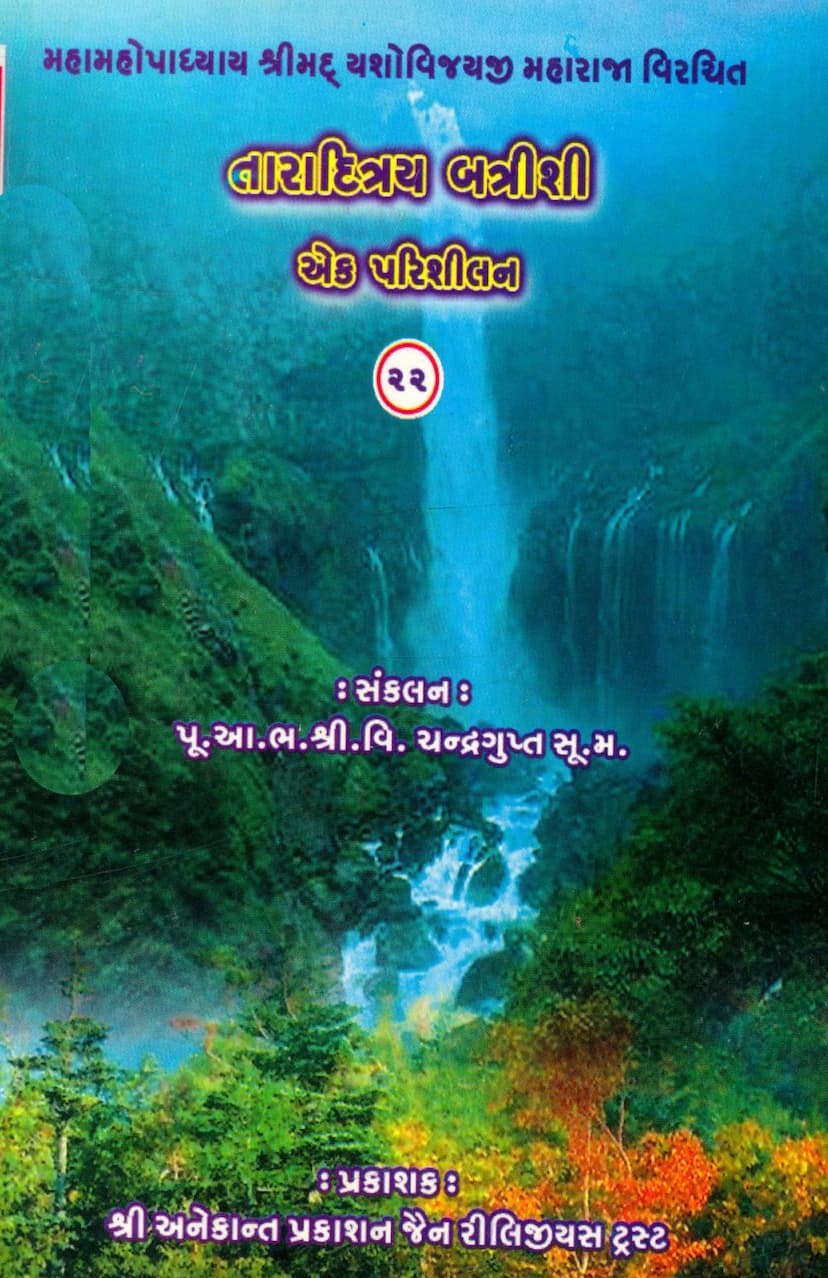Taraditray Battrishi Ek Parishilan
Added to library: September 2, 2025

Summary
This document, titled "Taraditray Battrishi Ek Parishilan," is a commentary and explanation of the "Dwatrishat-Dwatrishishta" (Thirty-Two Verses) by Mahamahopadhyaya Shrimad Yashovijayji Maharaj, compiled and elucidated by the esteemed Acharya Shri ChandraGupta Suri Maharaj. Published by Shri Anekant Prakashan, Jain Religious Trust, it focuses on the Tara, Bala, and Deepra stages (or perspectives) of spiritual development.
The text begins by referencing a previous work, "Mitra Battrishi," which described the Mitra (friend-like) stage. This current work delves into the three subsequent stages:
1. Tara Drishti (Star Perspective):
- Knowledge: Described as a faint spark, like embers from dried dung.
- Yoga's Eight Limbs: This stage corresponds to Niyama (observances).
- Eight Qualities of Yoga: Achieves the second quality, Tattva Jijnaasa (curiosity about truth).
- Eight Hindrances to Yoga: Overcomes the defect of Udvega (agitation).
- Key Characteristics:
- Slightly clearer perception than the Mitra stage.
- Practices auspicious observances (Niyamas).
- Absence of agitation when initiating beneficial actions.
- A growing curiosity to understand true reality.
- Acceptance of the words of wise individuals due to an absence of aversion towards truth.
- Develops an unbroken liking for yogic narratives.
- Offers respect and service (within one's capacity) to yogis.
- Reduces the fear of worldly existence (birth and death) as the influence of negative actions diminishes.
- Reflects on one's own imperfect conduct, causing distress.
- Experiences a curiosity about the pure conduct of yogis.
- The Five Niyamas described:
- Shaucha (Purity): Both external (cleanliness of body) and internal (purity of mind through virtues like friendship). Its fruits include disgust for one's own body, detachment from others' bodies, purity of the inner self (sattva), pleasantness, concentration, control over senses, and the qualification for self-realization.
- Santosha (Contentment): Leads to supreme happiness.
- Svadhyaya (Self-Study/Recitation): Leads to the vision of the desired (divine).
- Tapa (Austerity): Leads to perfection of the body and senses.
- Ishvara Pranidhana (Surrender to the Divine): Leads to Samadhi (deep meditation).
- The text emphasizes that the understanding of the utility of these practices leads to their adoption, even if partial.
2. Bala Drishti (Strong Perspective):
- Knowledge: Described as a spark like an ember from wood.
- Yoga's Eight Limbs: Corresponds to Asana (posture).
- Eight Qualities of Yoga: Attains Tattva Shushrusha (eagerness to serve the truth).
- Eight Hindrances to Yoga: Overcomes the defect of Kshepa (distraction).
- Key Characteristics:
- Firm and clear perception.
- Practices comfortable and stable postures (Asanas) that are not agitating.
- Possesses Tattva Shushrusha, a deep eagerness to learn about reality.
- Absence of the Kshepa defect, ensuring continuity in practice.
- The practice of Asana leads to victory over obstacles, invincibility against dualities (heat/cold, pleasure/pain), and abandonment of mental afflictions.
- A strong desire to listen to and understand the truth, akin to a young man with a beautiful wife desiring divine music.
- The fruit of Shushrusha (listening) is unwavering devotion to the Guru and, consequently, the vision of the Tirthankaras.
- The absence of Kshepa leads to skill in yogic practices and their progressive development.
3. Deepra Drishti (Radiant Perspective):
- Knowledge: Described as bright like a lamp.
- Yoga's Eight Limbs: Corresponds to Pranayama (breath control).
- Eight Qualities of Yoga: Attains Tattva Shravana (listening to the truth).
- Eight Hindrances to Yoga: Overcomes the defect of Utthana (restlessness/agitation).
- Key Characteristics:
- Possesses Pranayama.
- Free from Utthana.
- Engages in Tattva Shravana.
- Does not possess subtle understanding (Sukshma Bodha) because it hasn't attained Vedya Samvedya Pada (the state of being knowable and perceivable in its subtle essence).
- Pranayama is described in three types: Rechaka (exhalation), Puraka (inhalation), and Kumbhaka (retention). The text also discusses the importance of Bhava Pranayama (mental breath control) which is essential for spiritual progress.
- Through Bhava Pranayama, one understands that Dharma (righteousness/truth) is more valuable than life itself, leading to a willingness to sacrifice life for Dharma.
- Tattva Shravana (listening to truth) amplifies virtues, akin to watering a plant to help it grow.
- It leads to intense devotion to the Guru and the vision of Tirthankaras.
- The lack of subtle understanding is due to the absence of Vedya Samvedya Pada, which is achieved only after the disintegration of karmic bonds.
- The state of Avedya Samvedya Pada (unknowable and unperceivable state) is prevalent in the first four stages, likened to the shadow of a bird over water, where aquatic creatures mistake the shadow for the bird. This Avedya Samvedya Pada is not ultimate reality but a misapprehension.
- The text explains that Vedya Samvedya Pada is attained when karmic obstructions are broken, leading to a subtle understanding of reality's infinite facets.
- In the Avedya Samvedya Pada state, even beneficial actions (punya) can be tainted with the seeds of misfortune, making them "punya anubandhi papa" (meritorious acts leading to future suffering), and the attachment to worldly pleasures continues.
- The text concludes by stating that this Avedya Samvedya Pada, which leads to negative consequences, can be overcome by the company of the virtuous (Satsanga) and the study of scriptures (Agama Yoga). The aspiration is to conquer this state and attain supreme bliss.
In essence, "Taraditray Battrishi Ek Parishilan" provides a detailed, verse-by-verse commentary on the gradual progression of spiritual understanding and practice, moving from a nascent curiosity to a more profound engagement with truth, ultimately leading to the understanding of the paramount importance of Dharma over even life itself. It emphasizes the role of virtuous company and scriptural study in overcoming spiritual obstacles.